Rennes SB: Green Purchasing Report for Renault Group - 2023
VerifiedAdded on 2021/03/26
|8
|2659
|47
Report
AI Summary
This report provides a comprehensive analysis of the Renault Group's green purchasing practices and sustainability initiatives. It begins with an overview of the company's environmental challenges and strategic objectives, emphasizing its focus on electric vehicles, the circular economy, and autonomous driverless vehicles. The report then conducts a sustainability audit, examining governance, social impact on workers and civic engagement, environmental impacts through waste reduction, resource conservation, and carbon footprint reduction, as well as supplier engagement. The audit highlights Renault's progress in these areas, particularly its leadership in electric vehicle sales and circular economy practices. The report concludes with recommendations for further improvement, including increasing electric vehicle adoption, optimizing internal processes to reduce emissions and resource use, and addressing the environmental impact of battery production and energy sources. The report also suggests addressing the issue of fine particle emissions from brake wear and tear.
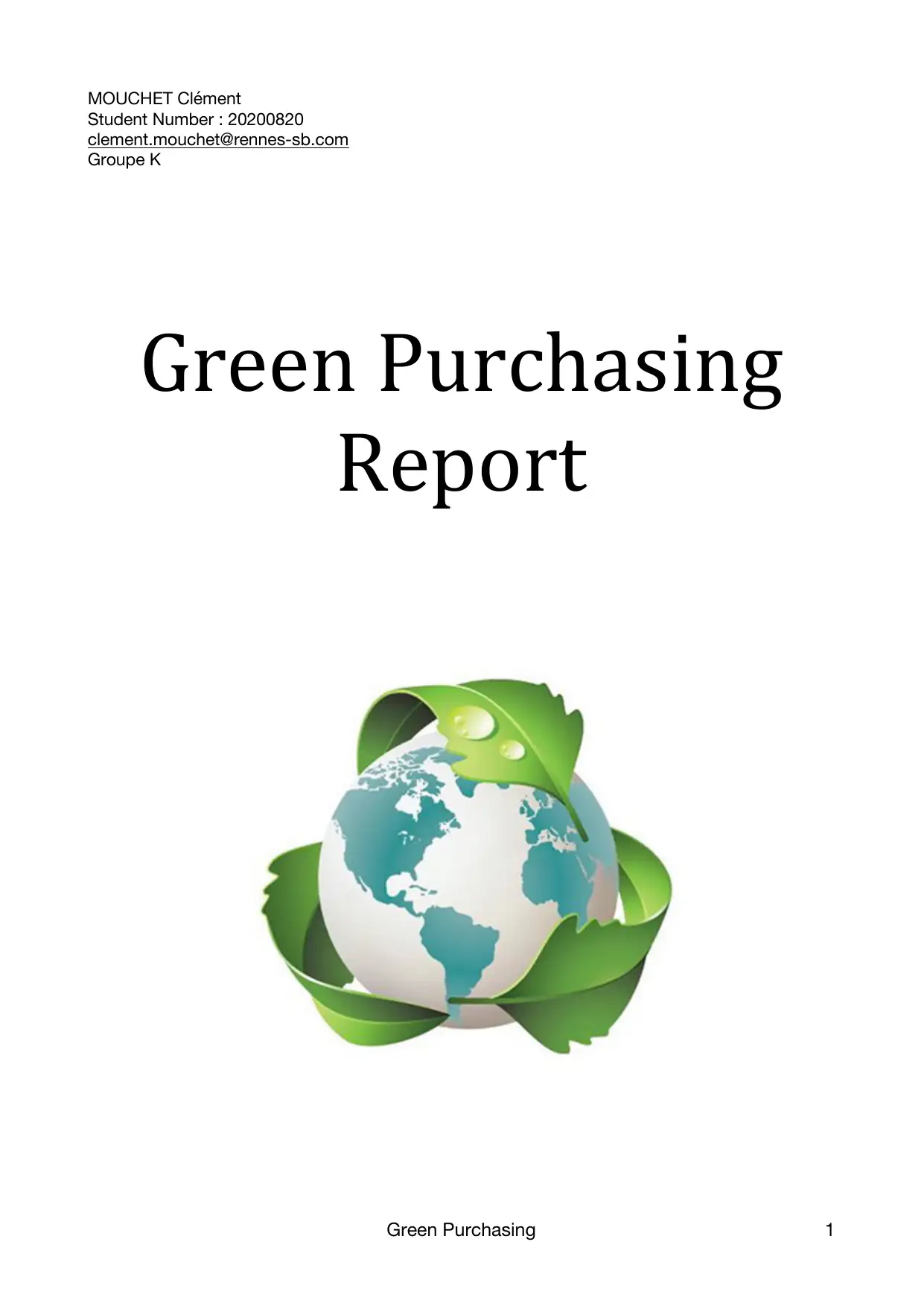
Green Purchasing 1
MOUCHET Clément
Student Number : 20200820
clement.mouchet@rennes-sb.com
Groupe K
Green Purchasing
Report
MOUCHET Clément
Student Number : 20200820
clement.mouchet@rennes-sb.com
Groupe K
Green Purchasing
Report
Paraphrase This Document
Need a fresh take? Get an instant paraphrase of this document with our AI Paraphraser
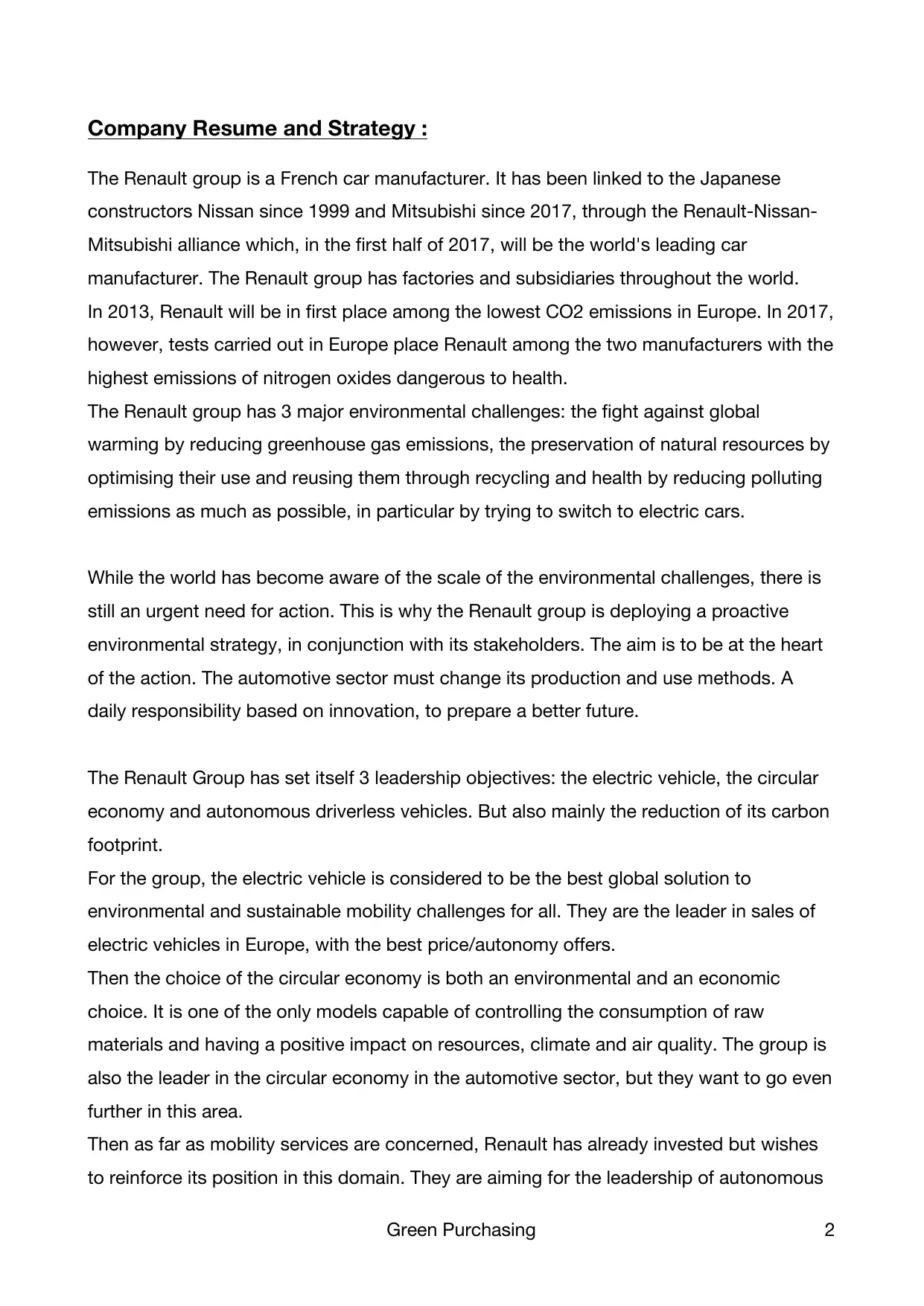
Green Purchasing 2
Company Resume and Strategy :
The Renault group is a French car manufacturer. It has been linked to the Japanese
constructors Nissan since 1999 and Mitsubishi since 2017, through the Renault-Nissan-
Mitsubishi alliance which, in the first half of 2017, will be the world's leading car
manufacturer. The Renault group has factories and subsidiaries throughout the world.
In 2013, Renault will be in first place among the lowest CO2 emissions in Europe. In 2017,
however, tests carried out in Europe place Renault among the two manufacturers with the
highest emissions of nitrogen oxides dangerous to health.
The Renault group has 3 major environmental challenges: the fight against global
warming by reducing greenhouse gas emissions, the preservation of natural resources by
optimising their use and reusing them through recycling and health by reducing polluting
emissions as much as possible, in particular by trying to switch to electric cars.
While the world has become aware of the scale of the environmental challenges, there is
still an urgent need for action. This is why the Renault group is deploying a proactive
environmental strategy, in conjunction with its stakeholders. The aim is to be at the heart
of the action. The automotive sector must change its production and use methods. A
daily responsibility based on innovation, to prepare a better future.
The Renault Group has set itself 3 leadership objectives: the electric vehicle, the circular
economy and autonomous driverless vehicles. But also mainly the reduction of its carbon
footprint.
For the group, the electric vehicle is considered to be the best global solution to
environmental and sustainable mobility challenges for all. They are the leader in sales of
electric vehicles in Europe, with the best price/autonomy offers.
Then the choice of the circular economy is both an environmental and an economic
choice. It is one of the only models capable of controlling the consumption of raw
materials and having a positive impact on resources, climate and air quality. The group is
also the leader in the circular economy in the automotive sector, but they want to go even
further in this area.
Then as far as mobility services are concerned, Renault has already invested but wishes
to reinforce its position in this domain. They are aiming for the leadership of autonomous
Company Resume and Strategy :
The Renault group is a French car manufacturer. It has been linked to the Japanese
constructors Nissan since 1999 and Mitsubishi since 2017, through the Renault-Nissan-
Mitsubishi alliance which, in the first half of 2017, will be the world's leading car
manufacturer. The Renault group has factories and subsidiaries throughout the world.
In 2013, Renault will be in first place among the lowest CO2 emissions in Europe. In 2017,
however, tests carried out in Europe place Renault among the two manufacturers with the
highest emissions of nitrogen oxides dangerous to health.
The Renault group has 3 major environmental challenges: the fight against global
warming by reducing greenhouse gas emissions, the preservation of natural resources by
optimising their use and reusing them through recycling and health by reducing polluting
emissions as much as possible, in particular by trying to switch to electric cars.
While the world has become aware of the scale of the environmental challenges, there is
still an urgent need for action. This is why the Renault group is deploying a proactive
environmental strategy, in conjunction with its stakeholders. The aim is to be at the heart
of the action. The automotive sector must change its production and use methods. A
daily responsibility based on innovation, to prepare a better future.
The Renault Group has set itself 3 leadership objectives: the electric vehicle, the circular
economy and autonomous driverless vehicles. But also mainly the reduction of its carbon
footprint.
For the group, the electric vehicle is considered to be the best global solution to
environmental and sustainable mobility challenges for all. They are the leader in sales of
electric vehicles in Europe, with the best price/autonomy offers.
Then the choice of the circular economy is both an environmental and an economic
choice. It is one of the only models capable of controlling the consumption of raw
materials and having a positive impact on resources, climate and air quality. The group is
also the leader in the circular economy in the automotive sector, but they want to go even
further in this area.
Then as far as mobility services are concerned, Renault has already invested but wishes
to reinforce its position in this domain. They are aiming for the leadership of autonomous
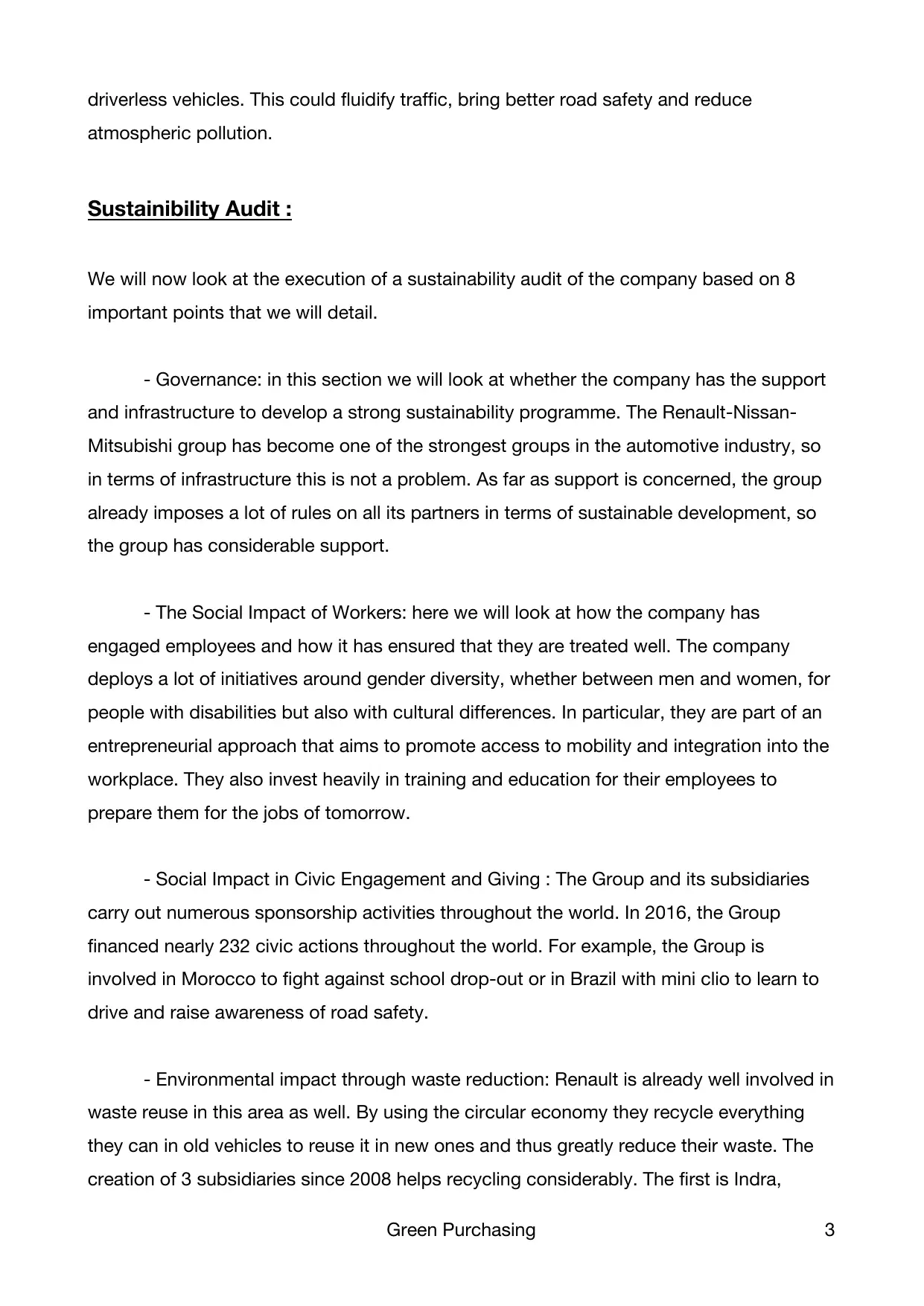
Green Purchasing 3
driverless vehicles. This could fluidify traffic, bring better road safety and reduce
atmospheric pollution.
Sustainibility Audit :
We will now look at the execution of a sustainability audit of the company based on 8
important points that we will detail.
- Governance: in this section we will look at whether the company has the support
and infrastructure to develop a strong sustainability programme. The Renault-Nissan-
Mitsubishi group has become one of the strongest groups in the automotive industry, so
in terms of infrastructure this is not a problem. As far as support is concerned, the group
already imposes a lot of rules on all its partners in terms of sustainable development, so
the group has considerable support.
- The Social Impact of Workers: here we will look at how the company has
engaged employees and how it has ensured that they are treated well. The company
deploys a lot of initiatives around gender diversity, whether between men and women, for
people with disabilities but also with cultural differences. In particular, they are part of an
entrepreneurial approach that aims to promote access to mobility and integration into the
workplace. They also invest heavily in training and education for their employees to
prepare them for the jobs of tomorrow.
- Social Impact in Civic Engagement and Giving : The Group and its subsidiaries
carry out numerous sponsorship activities throughout the world. In 2016, the Group
financed nearly 232 civic actions throughout the world. For example, the Group is
involved in Morocco to fight against school drop-out or in Brazil with mini clio to learn to
drive and raise awareness of road safety.
- Environmental impact through waste reduction: Renault is already well involved in
waste reuse in this area as well. By using the circular economy they recycle everything
they can in old vehicles to reuse it in new ones and thus greatly reduce their waste. The
creation of 3 subsidiaries since 2008 helps recycling considerably. The first is Indra,
driverless vehicles. This could fluidify traffic, bring better road safety and reduce
atmospheric pollution.
Sustainibility Audit :
We will now look at the execution of a sustainability audit of the company based on 8
important points that we will detail.
- Governance: in this section we will look at whether the company has the support
and infrastructure to develop a strong sustainability programme. The Renault-Nissan-
Mitsubishi group has become one of the strongest groups in the automotive industry, so
in terms of infrastructure this is not a problem. As far as support is concerned, the group
already imposes a lot of rules on all its partners in terms of sustainable development, so
the group has considerable support.
- The Social Impact of Workers: here we will look at how the company has
engaged employees and how it has ensured that they are treated well. The company
deploys a lot of initiatives around gender diversity, whether between men and women, for
people with disabilities but also with cultural differences. In particular, they are part of an
entrepreneurial approach that aims to promote access to mobility and integration into the
workplace. They also invest heavily in training and education for their employees to
prepare them for the jobs of tomorrow.
- Social Impact in Civic Engagement and Giving : The Group and its subsidiaries
carry out numerous sponsorship activities throughout the world. In 2016, the Group
financed nearly 232 civic actions throughout the world. For example, the Group is
involved in Morocco to fight against school drop-out or in Brazil with mini clio to learn to
drive and raise awareness of road safety.
- Environmental impact through waste reduction: Renault is already well involved in
waste reuse in this area as well. By using the circular economy they recycle everything
they can in old vehicles to reuse it in new ones and thus greatly reduce their waste. The
creation of 3 subsidiaries since 2008 helps recycling considerably. The first is Indra,
⊘ This is a preview!⊘
Do you want full access?
Subscribe today to unlock all pages.

Trusted by 1+ million students worldwide
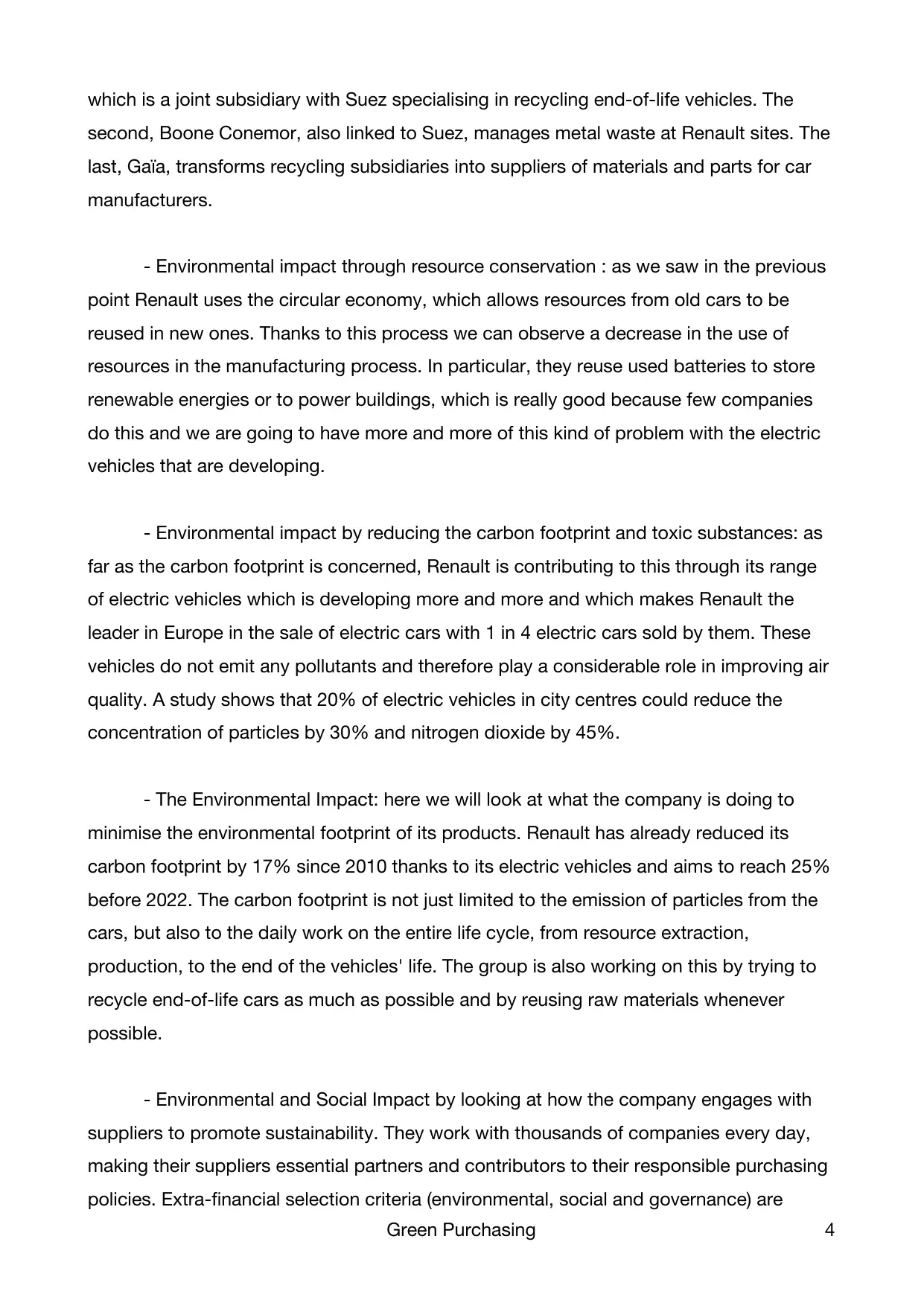
Green Purchasing 4
which is a joint subsidiary with Suez specialising in recycling end-of-life vehicles. The
second, Boone Conemor, also linked to Suez, manages metal waste at Renault sites. The
last, Gaïa, transforms recycling subsidiaries into suppliers of materials and parts for car
manufacturers.
- Environmental impact through resource conservation : as we saw in the previous
point Renault uses the circular economy, which allows resources from old cars to be
reused in new ones. Thanks to this process we can observe a decrease in the use of
resources in the manufacturing process. In particular, they reuse used batteries to store
renewable energies or to power buildings, which is really good because few companies
do this and we are going to have more and more of this kind of problem with the electric
vehicles that are developing.
- Environmental impact by reducing the carbon footprint and toxic substances: as
far as the carbon footprint is concerned, Renault is contributing to this through its range
of electric vehicles which is developing more and more and which makes Renault the
leader in Europe in the sale of electric cars with 1 in 4 electric cars sold by them. These
vehicles do not emit any pollutants and therefore play a considerable role in improving air
quality. A study shows that 20% of electric vehicles in city centres could reduce the
concentration of particles by 30% and nitrogen dioxide by 45%.
- The Environmental Impact: here we will look at what the company is doing to
minimise the environmental footprint of its products. Renault has already reduced its
carbon footprint by 17% since 2010 thanks to its electric vehicles and aims to reach 25%
before 2022. The carbon footprint is not just limited to the emission of particles from the
cars, but also to the daily work on the entire life cycle, from resource extraction,
production, to the end of the vehicles' life. The group is also working on this by trying to
recycle end-of-life cars as much as possible and by reusing raw materials whenever
possible.
- Environmental and Social Impact by looking at how the company engages with
suppliers to promote sustainability. They work with thousands of companies every day,
making their suppliers essential partners and contributors to their responsible purchasing
policies. Extra-financial selection criteria (environmental, social and governance) are
which is a joint subsidiary with Suez specialising in recycling end-of-life vehicles. The
second, Boone Conemor, also linked to Suez, manages metal waste at Renault sites. The
last, Gaïa, transforms recycling subsidiaries into suppliers of materials and parts for car
manufacturers.
- Environmental impact through resource conservation : as we saw in the previous
point Renault uses the circular economy, which allows resources from old cars to be
reused in new ones. Thanks to this process we can observe a decrease in the use of
resources in the manufacturing process. In particular, they reuse used batteries to store
renewable energies or to power buildings, which is really good because few companies
do this and we are going to have more and more of this kind of problem with the electric
vehicles that are developing.
- Environmental impact by reducing the carbon footprint and toxic substances: as
far as the carbon footprint is concerned, Renault is contributing to this through its range
of electric vehicles which is developing more and more and which makes Renault the
leader in Europe in the sale of electric cars with 1 in 4 electric cars sold by them. These
vehicles do not emit any pollutants and therefore play a considerable role in improving air
quality. A study shows that 20% of electric vehicles in city centres could reduce the
concentration of particles by 30% and nitrogen dioxide by 45%.
- The Environmental Impact: here we will look at what the company is doing to
minimise the environmental footprint of its products. Renault has already reduced its
carbon footprint by 17% since 2010 thanks to its electric vehicles and aims to reach 25%
before 2022. The carbon footprint is not just limited to the emission of particles from the
cars, but also to the daily work on the entire life cycle, from resource extraction,
production, to the end of the vehicles' life. The group is also working on this by trying to
recycle end-of-life cars as much as possible and by reusing raw materials whenever
possible.
- Environmental and Social Impact by looking at how the company engages with
suppliers to promote sustainability. They work with thousands of companies every day,
making their suppliers essential partners and contributors to their responsible purchasing
policies. Extra-financial selection criteria (environmental, social and governance) are
Paraphrase This Document
Need a fresh take? Get an instant paraphrase of this document with our AI Paraphraser
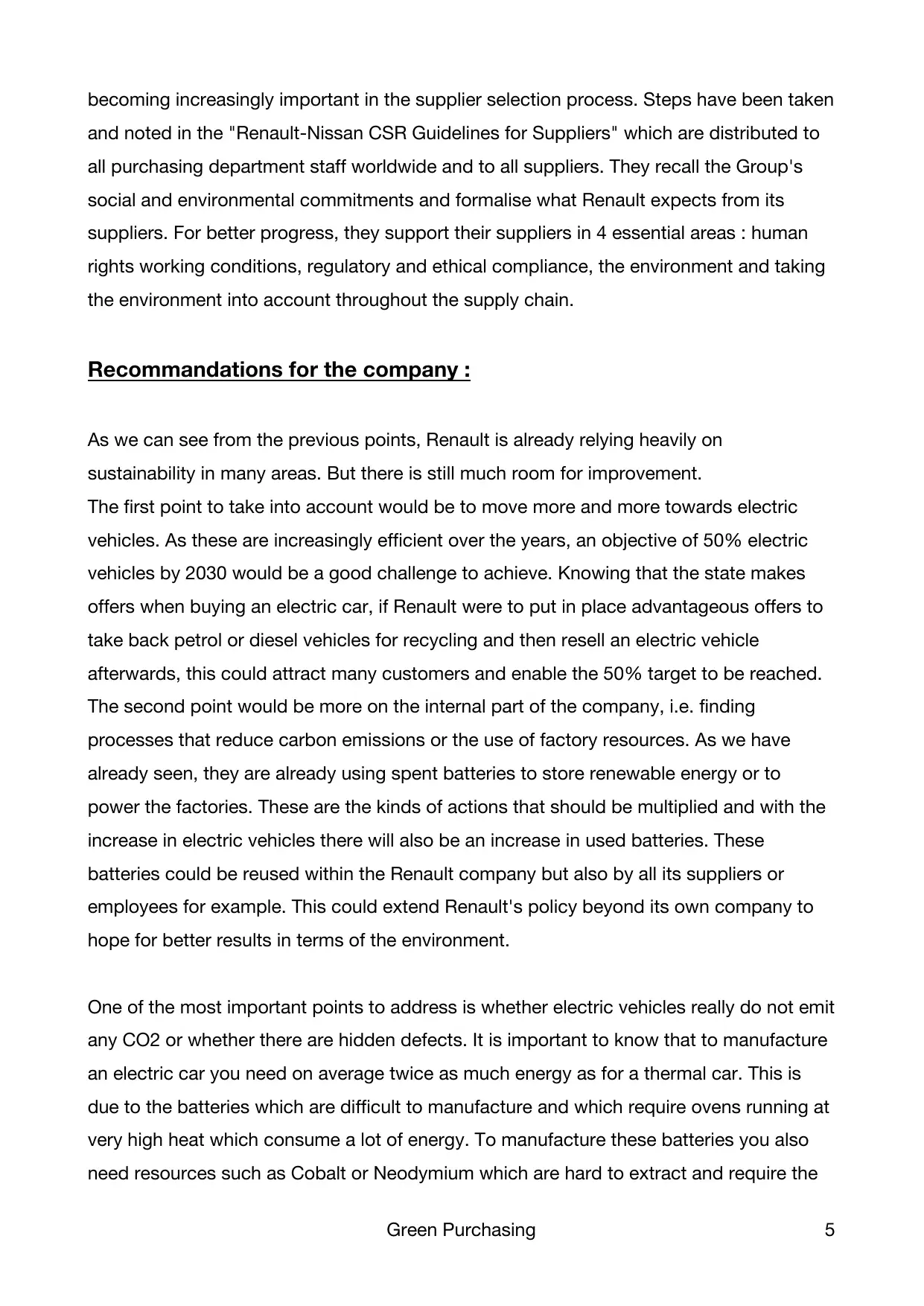
Green Purchasing 5
becoming increasingly important in the supplier selection process. Steps have been taken
and noted in the "Renault-Nissan CSR Guidelines for Suppliers" which are distributed to
all purchasing department staff worldwide and to all suppliers. They recall the Group's
social and environmental commitments and formalise what Renault expects from its
suppliers. For better progress, they support their suppliers in 4 essential areas : human
rights working conditions, regulatory and ethical compliance, the environment and taking
the environment into account throughout the supply chain.
Recommandations for the company :
As we can see from the previous points, Renault is already relying heavily on
sustainability in many areas. But there is still much room for improvement.
The first point to take into account would be to move more and more towards electric
vehicles. As these are increasingly efficient over the years, an objective of 50% electric
vehicles by 2030 would be a good challenge to achieve. Knowing that the state makes
offers when buying an electric car, if Renault were to put in place advantageous offers to
take back petrol or diesel vehicles for recycling and then resell an electric vehicle
afterwards, this could attract many customers and enable the 50% target to be reached.
The second point would be more on the internal part of the company, i.e. finding
processes that reduce carbon emissions or the use of factory resources. As we have
already seen, they are already using spent batteries to store renewable energy or to
power the factories. These are the kinds of actions that should be multiplied and with the
increase in electric vehicles there will also be an increase in used batteries. These
batteries could be reused within the Renault company but also by all its suppliers or
employees for example. This could extend Renault's policy beyond its own company to
hope for better results in terms of the environment.
One of the most important points to address is whether electric vehicles really do not emit
any CO2 or whether there are hidden defects. It is important to know that to manufacture
an electric car you need on average twice as much energy as for a thermal car. This is
due to the batteries which are difficult to manufacture and which require ovens running at
very high heat which consume a lot of energy. To manufacture these batteries you also
need resources such as Cobalt or Neodymium which are hard to extract and require the
becoming increasingly important in the supplier selection process. Steps have been taken
and noted in the "Renault-Nissan CSR Guidelines for Suppliers" which are distributed to
all purchasing department staff worldwide and to all suppliers. They recall the Group's
social and environmental commitments and formalise what Renault expects from its
suppliers. For better progress, they support their suppliers in 4 essential areas : human
rights working conditions, regulatory and ethical compliance, the environment and taking
the environment into account throughout the supply chain.
Recommandations for the company :
As we can see from the previous points, Renault is already relying heavily on
sustainability in many areas. But there is still much room for improvement.
The first point to take into account would be to move more and more towards electric
vehicles. As these are increasingly efficient over the years, an objective of 50% electric
vehicles by 2030 would be a good challenge to achieve. Knowing that the state makes
offers when buying an electric car, if Renault were to put in place advantageous offers to
take back petrol or diesel vehicles for recycling and then resell an electric vehicle
afterwards, this could attract many customers and enable the 50% target to be reached.
The second point would be more on the internal part of the company, i.e. finding
processes that reduce carbon emissions or the use of factory resources. As we have
already seen, they are already using spent batteries to store renewable energy or to
power the factories. These are the kinds of actions that should be multiplied and with the
increase in electric vehicles there will also be an increase in used batteries. These
batteries could be reused within the Renault company but also by all its suppliers or
employees for example. This could extend Renault's policy beyond its own company to
hope for better results in terms of the environment.
One of the most important points to address is whether electric vehicles really do not emit
any CO2 or whether there are hidden defects. It is important to know that to manufacture
an electric car you need on average twice as much energy as for a thermal car. This is
due to the batteries which are difficult to manufacture and which require ovens running at
very high heat which consume a lot of energy. To manufacture these batteries you also
need resources such as Cobalt or Neodymium which are hard to extract and require the
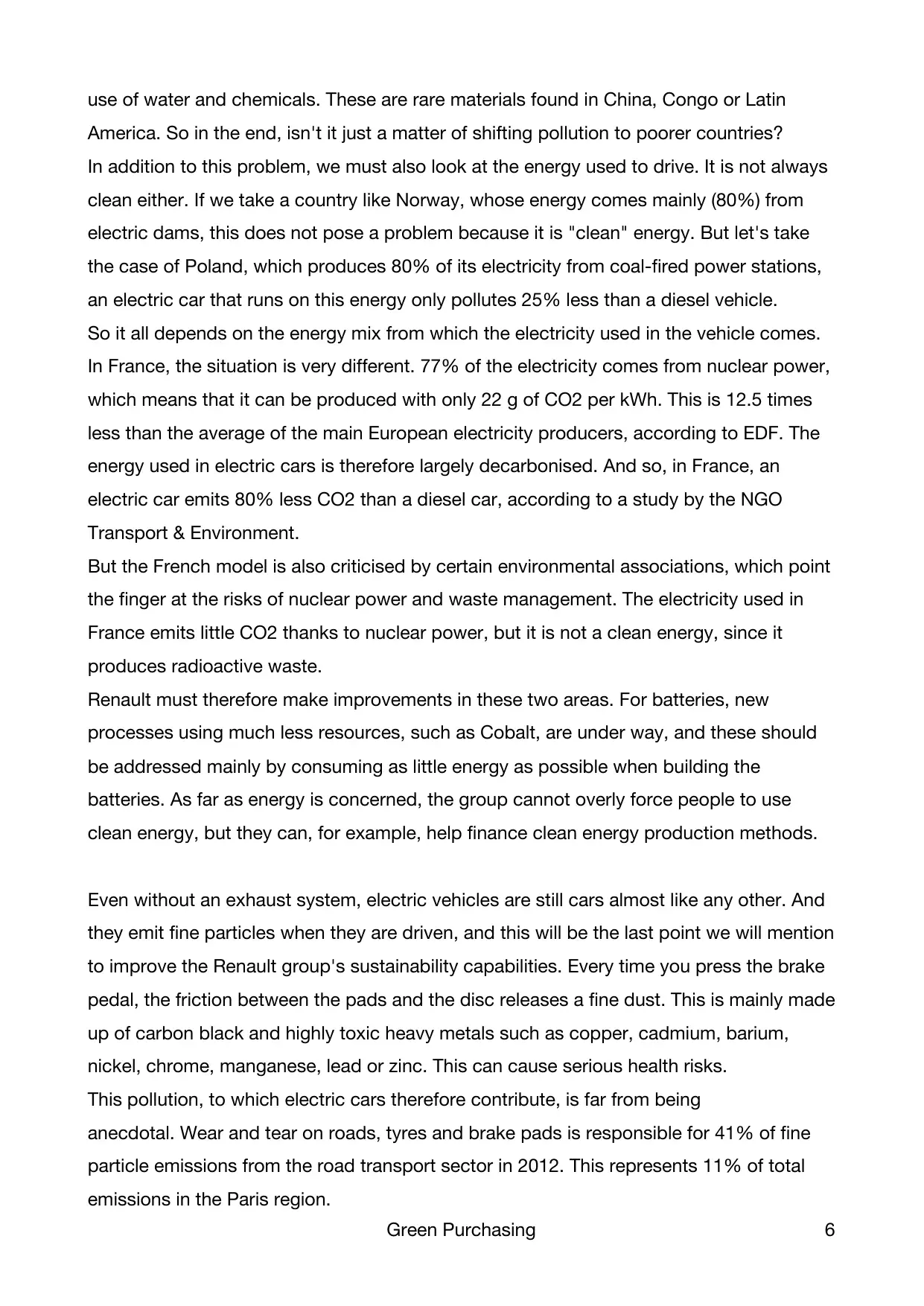
Green Purchasing 6
use of water and chemicals. These are rare materials found in China, Congo or Latin
America. So in the end, isn't it just a matter of shifting pollution to poorer countries?
In addition to this problem, we must also look at the energy used to drive. It is not always
clean either. If we take a country like Norway, whose energy comes mainly (80%) from
electric dams, this does not pose a problem because it is "clean" energy. But let's take
the case of Poland, which produces 80% of its electricity from coal-fired power stations,
an electric car that runs on this energy only pollutes 25% less than a diesel vehicle.
So it all depends on the energy mix from which the electricity used in the vehicle comes.
In France, the situation is very different. 77% of the electricity comes from nuclear power,
which means that it can be produced with only 22 g of CO2 per kWh. This is 12.5 times
less than the average of the main European electricity producers, according to EDF. The
energy used in electric cars is therefore largely decarbonised. And so, in France, an
electric car emits 80% less CO2 than a diesel car, according to a study by the NGO
Transport & Environment.
But the French model is also criticised by certain environmental associations, which point
the finger at the risks of nuclear power and waste management. The electricity used in
France emits little CO2 thanks to nuclear power, but it is not a clean energy, since it
produces radioactive waste.
Renault must therefore make improvements in these two areas. For batteries, new
processes using much less resources, such as Cobalt, are under way, and these should
be addressed mainly by consuming as little energy as possible when building the
batteries. As far as energy is concerned, the group cannot overly force people to use
clean energy, but they can, for example, help finance clean energy production methods.
Even without an exhaust system, electric vehicles are still cars almost like any other. And
they emit fine particles when they are driven, and this will be the last point we will mention
to improve the Renault group's sustainability capabilities. Every time you press the brake
pedal, the friction between the pads and the disc releases a fine dust. This is mainly made
up of carbon black and highly toxic heavy metals such as copper, cadmium, barium,
nickel, chrome, manganese, lead or zinc. This can cause serious health risks.
This pollution, to which electric cars therefore contribute, is far from being
anecdotal. Wear and tear on roads, tyres and brake pads is responsible for 41% of fine
particle emissions from the road transport sector in 2012. This represents 11% of total
emissions in the Paris region.
use of water and chemicals. These are rare materials found in China, Congo or Latin
America. So in the end, isn't it just a matter of shifting pollution to poorer countries?
In addition to this problem, we must also look at the energy used to drive. It is not always
clean either. If we take a country like Norway, whose energy comes mainly (80%) from
electric dams, this does not pose a problem because it is "clean" energy. But let's take
the case of Poland, which produces 80% of its electricity from coal-fired power stations,
an electric car that runs on this energy only pollutes 25% less than a diesel vehicle.
So it all depends on the energy mix from which the electricity used in the vehicle comes.
In France, the situation is very different. 77% of the electricity comes from nuclear power,
which means that it can be produced with only 22 g of CO2 per kWh. This is 12.5 times
less than the average of the main European electricity producers, according to EDF. The
energy used in electric cars is therefore largely decarbonised. And so, in France, an
electric car emits 80% less CO2 than a diesel car, according to a study by the NGO
Transport & Environment.
But the French model is also criticised by certain environmental associations, which point
the finger at the risks of nuclear power and waste management. The electricity used in
France emits little CO2 thanks to nuclear power, but it is not a clean energy, since it
produces radioactive waste.
Renault must therefore make improvements in these two areas. For batteries, new
processes using much less resources, such as Cobalt, are under way, and these should
be addressed mainly by consuming as little energy as possible when building the
batteries. As far as energy is concerned, the group cannot overly force people to use
clean energy, but they can, for example, help finance clean energy production methods.
Even without an exhaust system, electric vehicles are still cars almost like any other. And
they emit fine particles when they are driven, and this will be the last point we will mention
to improve the Renault group's sustainability capabilities. Every time you press the brake
pedal, the friction between the pads and the disc releases a fine dust. This is mainly made
up of carbon black and highly toxic heavy metals such as copper, cadmium, barium,
nickel, chrome, manganese, lead or zinc. This can cause serious health risks.
This pollution, to which electric cars therefore contribute, is far from being
anecdotal. Wear and tear on roads, tyres and brake pads is responsible for 41% of fine
particle emissions from the road transport sector in 2012. This represents 11% of total
emissions in the Paris region.
⊘ This is a preview!⊘
Do you want full access?
Subscribe today to unlock all pages.

Trusted by 1+ million students worldwide
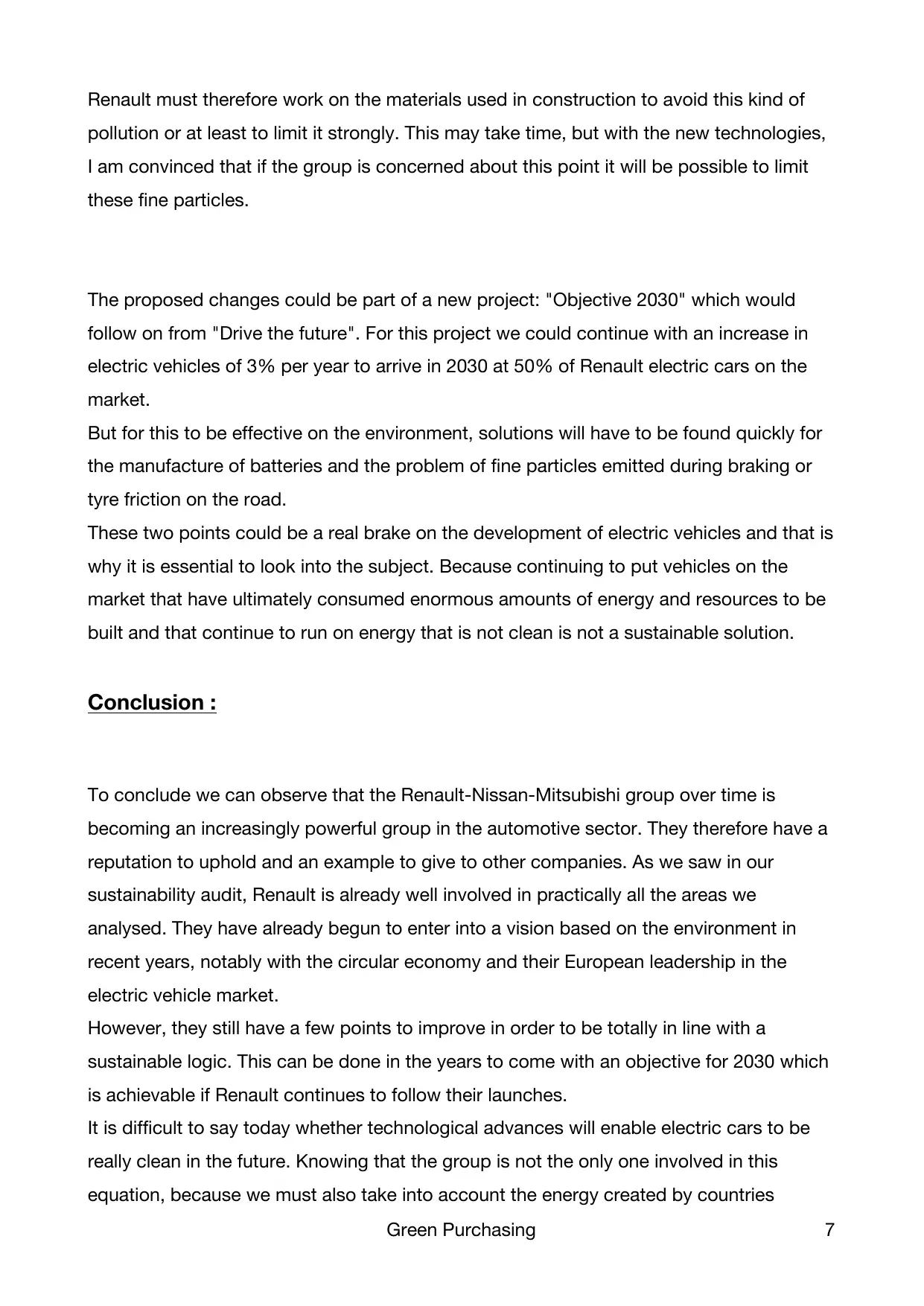
Green Purchasing 7
Renault must therefore work on the materials used in construction to avoid this kind of
pollution or at least to limit it strongly. This may take time, but with the new technologies,
I am convinced that if the group is concerned about this point it will be possible to limit
these fine particles.
The proposed changes could be part of a new project: "Objective 2030" which would
follow on from "Drive the future". For this project we could continue with an increase in
electric vehicles of 3% per year to arrive in 2030 at 50% of Renault electric cars on the
market.
But for this to be effective on the environment, solutions will have to be found quickly for
the manufacture of batteries and the problem of fine particles emitted during braking or
tyre friction on the road.
These two points could be a real brake on the development of electric vehicles and that is
why it is essential to look into the subject. Because continuing to put vehicles on the
market that have ultimately consumed enormous amounts of energy and resources to be
built and that continue to run on energy that is not clean is not a sustainable solution.
Conclusion :
To conclude we can observe that the Renault-Nissan-Mitsubishi group over time is
becoming an increasingly powerful group in the automotive sector. They therefore have a
reputation to uphold and an example to give to other companies. As we saw in our
sustainability audit, Renault is already well involved in practically all the areas we
analysed. They have already begun to enter into a vision based on the environment in
recent years, notably with the circular economy and their European leadership in the
electric vehicle market.
However, they still have a few points to improve in order to be totally in line with a
sustainable logic. This can be done in the years to come with an objective for 2030 which
is achievable if Renault continues to follow their launches.
It is difficult to say today whether technological advances will enable electric cars to be
really clean in the future. Knowing that the group is not the only one involved in this
equation, because we must also take into account the energy created by countries
Renault must therefore work on the materials used in construction to avoid this kind of
pollution or at least to limit it strongly. This may take time, but with the new technologies,
I am convinced that if the group is concerned about this point it will be possible to limit
these fine particles.
The proposed changes could be part of a new project: "Objective 2030" which would
follow on from "Drive the future". For this project we could continue with an increase in
electric vehicles of 3% per year to arrive in 2030 at 50% of Renault electric cars on the
market.
But for this to be effective on the environment, solutions will have to be found quickly for
the manufacture of batteries and the problem of fine particles emitted during braking or
tyre friction on the road.
These two points could be a real brake on the development of electric vehicles and that is
why it is essential to look into the subject. Because continuing to put vehicles on the
market that have ultimately consumed enormous amounts of energy and resources to be
built and that continue to run on energy that is not clean is not a sustainable solution.
Conclusion :
To conclude we can observe that the Renault-Nissan-Mitsubishi group over time is
becoming an increasingly powerful group in the automotive sector. They therefore have a
reputation to uphold and an example to give to other companies. As we saw in our
sustainability audit, Renault is already well involved in practically all the areas we
analysed. They have already begun to enter into a vision based on the environment in
recent years, notably with the circular economy and their European leadership in the
electric vehicle market.
However, they still have a few points to improve in order to be totally in line with a
sustainable logic. This can be done in the years to come with an objective for 2030 which
is achievable if Renault continues to follow their launches.
It is difficult to say today whether technological advances will enable electric cars to be
really clean in the future. Knowing that the group is not the only one involved in this
equation, because we must also take into account the energy created by countries
Paraphrase This Document
Need a fresh take? Get an instant paraphrase of this document with our AI Paraphraser
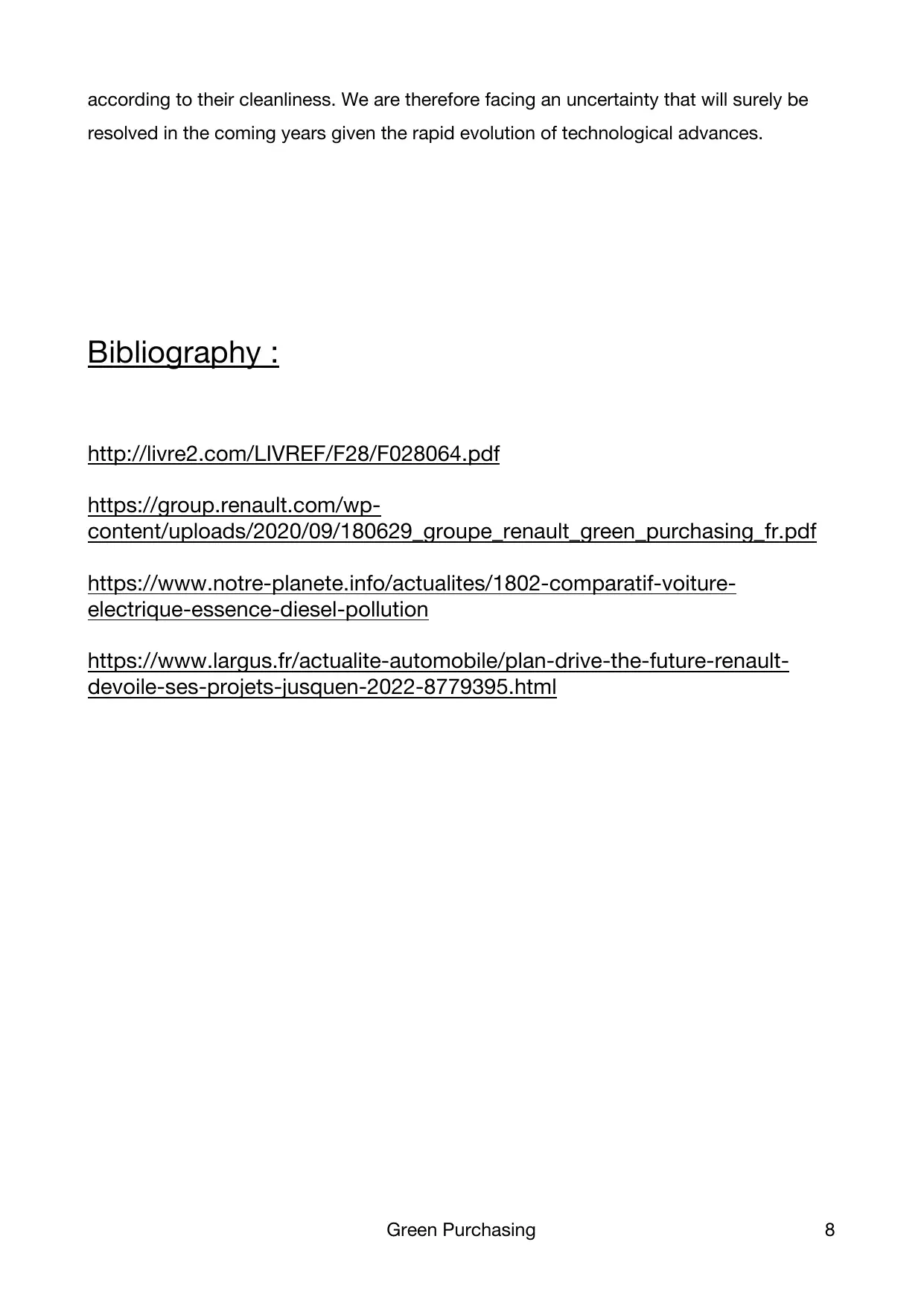
Green Purchasing 8
according to their cleanliness. We are therefore facing an uncertainty that will surely be
resolved in the coming years given the rapid evolution of technological advances.
Bibliography :
http://livre2.com/LIVREF/F28/F028064.pdf
https://group.renault.com/wp-
content/uploads/2020/09/180629_groupe_renault_green_purchasing_fr.pdf
https://www.notre-planete.info/actualites/1802-comparatif-voiture-
electrique-essence-diesel-pollution
https://www.largus.fr/actualite-automobile/plan-drive-the-future-renault-
devoile-ses-projets-jusquen-2022-8779395.html
according to their cleanliness. We are therefore facing an uncertainty that will surely be
resolved in the coming years given the rapid evolution of technological advances.
Bibliography :
http://livre2.com/LIVREF/F28/F028064.pdf
https://group.renault.com/wp-
content/uploads/2020/09/180629_groupe_renault_green_purchasing_fr.pdf
https://www.notre-planete.info/actualites/1802-comparatif-voiture-
electrique-essence-diesel-pollution
https://www.largus.fr/actualite-automobile/plan-drive-the-future-renault-
devoile-ses-projets-jusquen-2022-8779395.html
1 out of 8
Related Documents
Your All-in-One AI-Powered Toolkit for Academic Success.
+13062052269
info@desklib.com
Available 24*7 on WhatsApp / Email
![[object Object]](/_next/static/media/star-bottom.7253800d.svg)
Unlock your academic potential
Copyright © 2020–2025 A2Z Services. All Rights Reserved. Developed and managed by ZUCOL.





